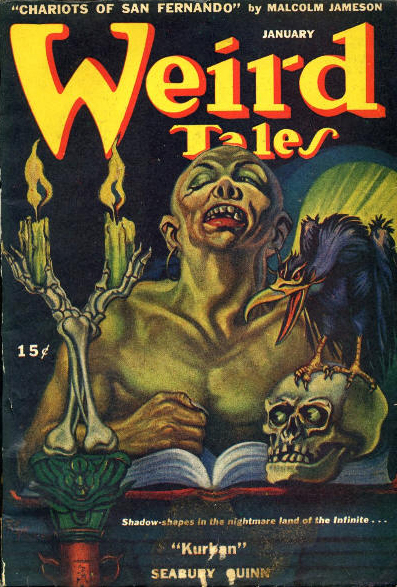Francis Hard, aka Farnsworth Wright, had a poem called "Two Crows" in the January 1925 issue of Weird Tales. Just six years earlier, Wright had been a soldier stationed in France. In composing his poem, he must have drawn on memories of the Great War:
Two Crows
By Francis Hard (Weird Tales, Jan. 1925)
Two crows flapped over dismally
(So wearily, so drearily)
To the blackened limb of a blasted tree;
The shells flew screaming overhead,
And the field was covered thick with dead--
The earth reeked with its dead.
One crow lamented to his mate
(So wearily, so drearily):
"How long, how long must we now wait
For the taste of food that was so good
Before the shrapnel shattered the wood
And loaded the ground with dead?
"The odor sweet of dying men"
(Lamented he so drearily),
"How strangely pleasant was it when
I sensed it first with ravished breath!
But I am sated, and sick to death,
And would fain lie yon with the dead."
A shell came moaning through the air
(So drearily, so eerily)
And burst where the crows were plaining there;
It shivered the wreck of the blasted tree,
And bits of crow fell bloodily
Among the tangled dead.
* * *
A year and a month later, in February 1926, in his capacity as editor, Wright placed a traditional ballad called "The Twa Corbies" ("The Two Crows") in Weird Tales:
The Twa Corbies
(Old Ballad)
[By Anonymous]
As I was walking all alane,
I heard twa corbies making a mane.
The tane unto the tother say:
Where sail we gang and dine today?
In behint yon auld fail dike
I wot there lies a new-slain knight.
Naebody kens that he lies there
But his hawk, his hound, and his lady fair.
His hound is to the hunting gone,
His hawk to fetch the wild-fowl hame,
His lady's ta'en another mate,
So we may mak our dinner sweet.
I'll sit on his white hause-bane,
Ye'll pick out his bonny blue een,
Wi' ae lock o' his gowden hair
We’ll theek our nest when it grows bare.
Mony a one for him makes mane,
But nane sail ken where he is gane.
O'er his white banes, when they are bare,
The wind sall blaw for evermair.
* * *
"The Twa Corbies" was first in print in 1812. A century later, it was reprinted in Ballads Weird and Wonderful (1912), illustrated by Vernon Hill (1887-1972). It seems to me that Farnsworth Wright had read "The Twa Corbies" and was inspired by it in writing his own poem. The refrain, the repeated "wearily," "drearily," and "eerily," would seem to have been inspired by "The Raven" by Edgar Allan Poe and its own refrain of "evermore" and "nevermore," also from its opening line:
Once upon a midnight dreary, while I pondered, weak and weary,
I wrote about "The Twa Corbies" on December 19, 2022. You can read what I wrote by clicking here.
Two corvids on the cover of Weird Tales:
 |
| Weird Tales, July 1945, cover art by Lee Brown Coye. |
 |
| Weird Tales, September 1939, cover art by Virgil Finlay. |

Based on the highly-stylized cover by Tilburne, it looks to me like a bizzare riff on EAP's The Raven. Nonetheless, a corvid! Good post on some WT esoterica.
ReplyDeleteHi, John,
DeleteI hadn't considered that Tilburne's cover is a riff on "The Raven." Thanks for the insight.
TH